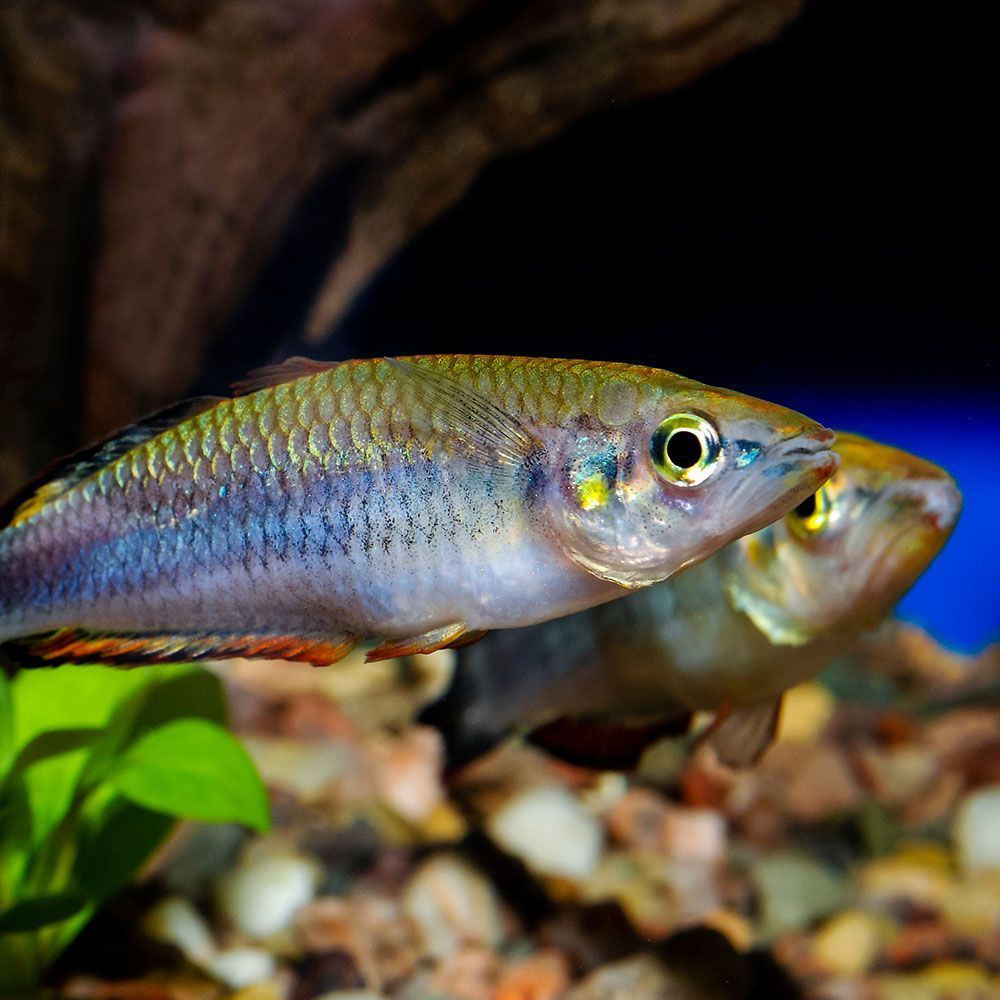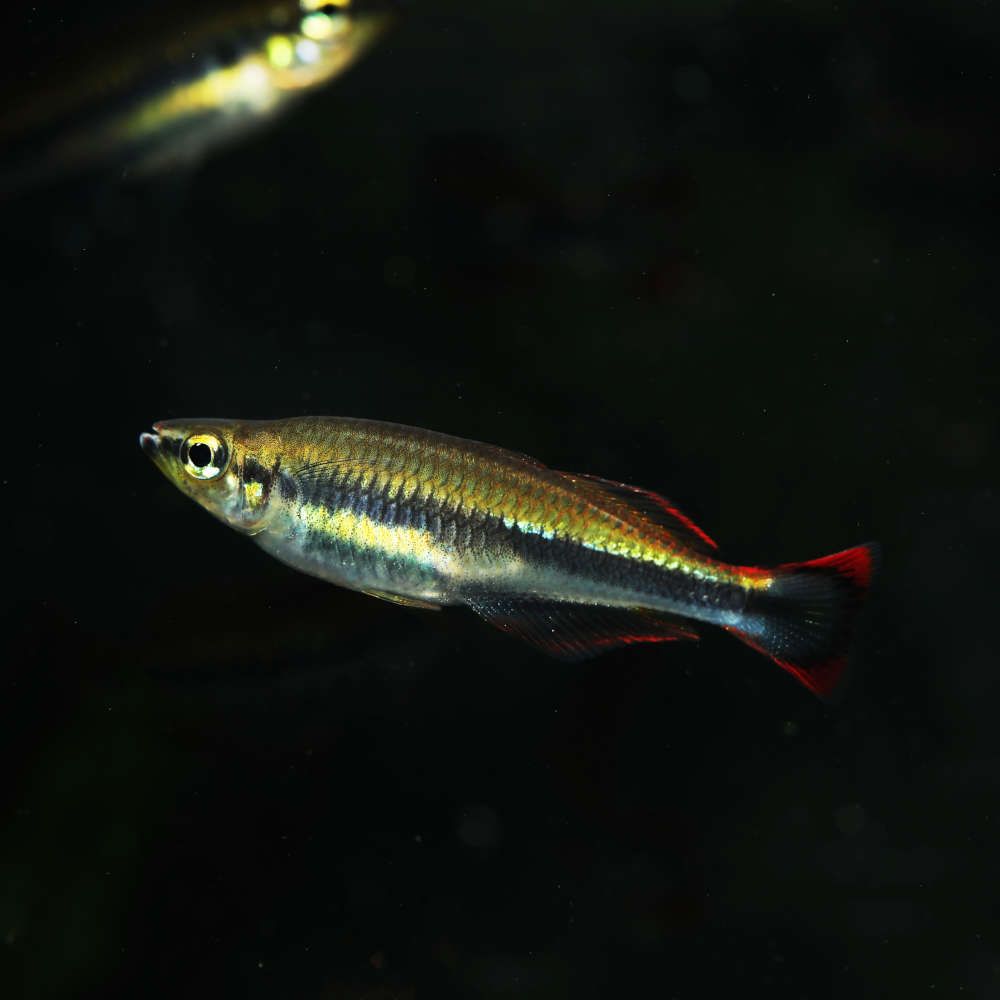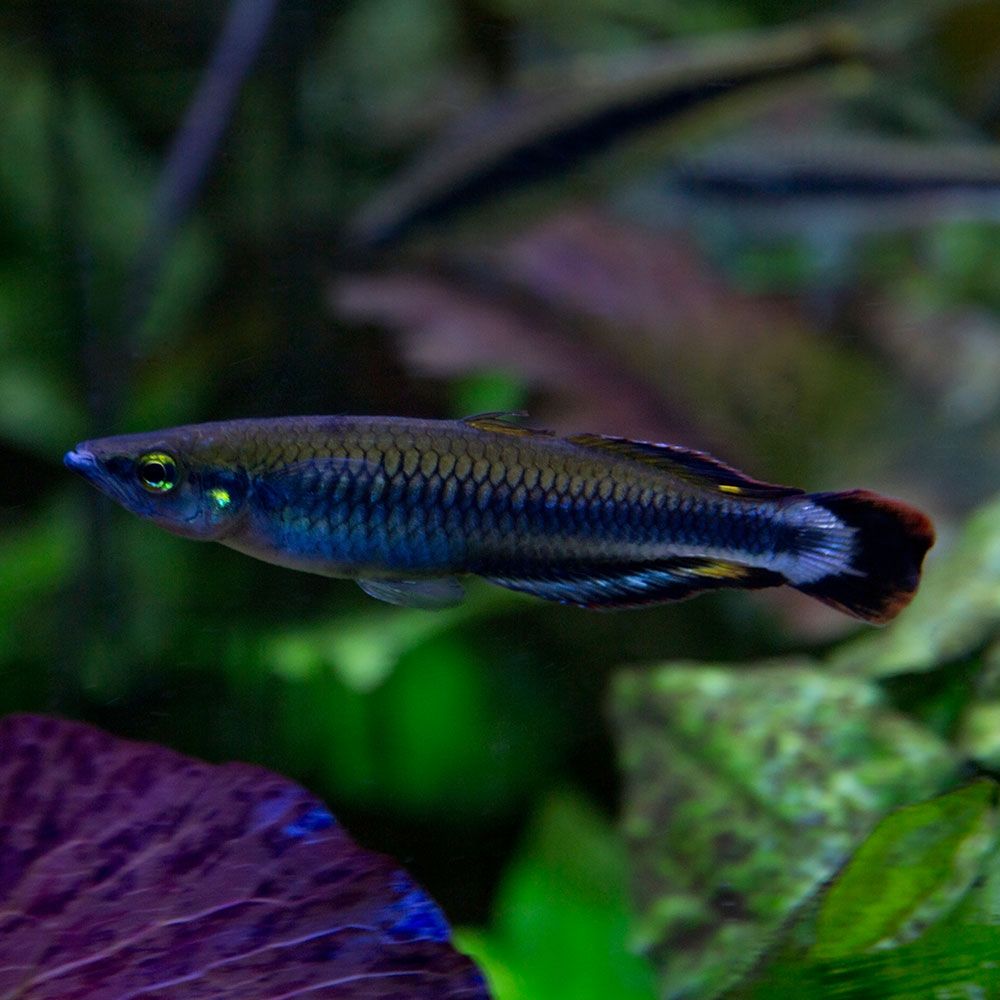The Madagascar rainbowfish is most sought after for its vibrant color patterns. This peaceful freshwater fish is suitable for community tanks with many other species.
With slight experience in aquariums and fishkeeping, you can easily master raising this fish.
Now, if you are curious to know more about this darling, read on!
What is a Madagascar Rainbowfish?
Madagascar Rainbow fish is an endangered freshwater fish which is known for its vibrant rainbow colors in the water.
| Origin | Ivoloina, Manambolo, Atsinanana region of eastern Madagascar, Africa |
| Order | Atheriniformes |
| Family | Bedotiidae |
| Scientific Name | Bedotia madagascariensis |
| Common Names | Madagascar rainbow fish, Madagascar rainbow, Madagascan rainbow fish, Red-tailed silverside, Zona |
| IUCN Red List Status | Endangered |
| Appearance | Yellowish body, blue/black lateral stripe, large eyes, red margin on fin |
| Size | Usually up to 8-8.6 cm (3.2-3.4 in), maximum length: 10 cm (4 in) |
| Lifespan | Usually up to 5 years, max 11 years |
| Temperament | Peaceful |
| Tank Level | Top to middle dwelling |
| Water Temperature | 72-77 °F (22-25 °C) |
| pH Level | 6-7.5 |
| Water Hardness | 8-15 dGH |
| Care Level | Intermediate |
| Minimum Tank Size | 150 gallons for 5-6 adults, 30 gallons for 5-6 juveniles |
| Tank Environment | Spacious, vegetated, well-lit, soft substrate, gentle water flow |
| Diet | Omnivorous |
| Tank Mates | Own group, other rainbowfish, other similar-sized, peaceful fish |
What is the Natural Habitat of Madagascar Rainbowfish?
The Madagascar rainbow fish naturally inhabits the lower reaches of the rivers, which drain into lagoons and lakes in the Atsinanana region of eastern Madagascar, Africa. It can also be found in the small streams of this region.
The lower reach of River Ivoloina is its home, situated just north of Toamasina city. This distribution extends up to the Manambalo Creek, which enters the Canal des Pangalanes in the south of Vatomandry.
The fish is usually spotted in clear, slow-flowing, shaded soft freshwater. But it’s also found in tannin-stained, low pH, blackwater swamps.
The Madagascar rainbow was also translocated to the marshes near the village of Mahitsy in the 1950s. Currently, it can be seen in the Betsiboka basin as well.
It is typically found at a height of about 500 m above sea level. The young fish usually stay in shallow areas, while the mature ones are seen in greater depths.
According to The IUCN Red List of Threatened Species 2016 assessment, this fish is listed as Endangered.
This is due to overfishing, rapid deforestation, and threat from other introduced invasive species like Asian snakehead fish (China).
Which family does Madagascar Rainbowfish belong?
The fish belongs to the Bedotiidae family under the Atheriniformes order and is scientifically known as Bedotia madagascariensis.
However, this species is also known by many common names like Madagascar rainbow fish, Madagascar rainbow, Madagascan rainbow fish, Red-tailed silverside and Zona.
Fun Fact: Madagascar rainbow fish is often misidentified and traded as another fish called Bedotia geayi – native to a place called Mananjary.
How does Madagascar Rainbowfish look?

Now, if you are curious about what this fish looks like, let us tell you all the details here!
What is the size of Madagascar Rainbowfish?
Madagascar rainbows usually grow up to 8-8.6 cm (3.2-3.4 in). But its maximum length is 10 cm (4 in).
What is the color of Madagascar Rainbowfish?
The light yellowish to orange-brown coloring of the skin makes the Madagascar rainbowfish quite interesting.
It has shimmery silver scales and some black markings all over the center of its body. The fins and tail of this species are clear and red-tipped.
A lateral strip extends from its mouth to the caudal fin. It looks black but can appear neon blue because this fish can flash it on and off.
What are the features of Madagascar Rainbowfish?
The Madagascar rainbow has a slender body that helps it swim through calm waters easily.
Its torpedo-shaped body is laterally compressed and features large eyes. It has short but strong fins.
Is there any difference between a male and a female Madagascar Rainbowfish?
A mature male Madagascar rainbow has black fins, which bloom into red color.
On the other hand, the adult female fish has a milder coloration of transparent fins. The color of the female’s body is also lighter as compared to the male.
The male has a pointier dorsal fin, while the females have a rounded, deeper body.
How do Madagascar Rainbowfish behave in the tank?
The Madagascar rainbowfish is tolerant towards most species of its own size and temperament.
It is a peaceful species which does well in a community of its own. But, fights can break out in a group of these fish if there are not enough members.
The lively fish likes to live within schools of at least 5 individuals as it is naturally social.
What is the Lifespan of Madagascar Rainbowfish?
The usual lifespan for the Madagascar rainbow fish is up to 5 years. However, in my experience, if it receives the best care, it can live up to 11 years.
Beware because poor care of this may drastically minimize its longevity to one year!
Author’s Note: This fish is polygamous, and each male reproduces with several females in each season.
How to take care of Madagascar Rainbow Fish?

Now, if you want this fish in your aquarium, you must prepare the perfect place for it to thrive. So read the next section with absolute attention!
What is the Tank Size of Madagascar Rainbowfish?
This fish should be kept in a school of 5-6. For adults, you need a tank of 150 gallons. But if you have 5-6 juveniles, you can use a tank of 55 gallons.
Tip: It may often jump out of the tank, so make sure the tank also has a tight lid.
What is the Water Chemistry for Madagascar Rainbowfish?
The Madagascar rainbowfish is intolerant to bad water conditions. So, maintain these parameters strictly to give your fish a suitable environment.
- pH Levels: 6-7.5
- Water Temperature: 72-77 °F (22-25 °C)
- Water Hardness: 8-15 dGH
- Ammonia: 0 ppm
- Nitrite: 0 ppm
- Nitrate: Below 50 ppm
What is the Tank Environment for Madagascar Rainbowfish?
Your fish needs a good home to thrive, so offer it a perfect environment by maintaining a homely décor of your tank.
Which Substrate is needed for Madagascar Rainbowfish?
The Madagascar rainbowfish typically does not interact with the bottom water column. But use a soft substrate just to be cautious and avoid the active fish injuring itself.
Use fine sand, fine gravel, river rocks, or plant substrate to replicate the natural conditions.
A dark-colored substrate will do wonders for your tank as it will contrast the beautiful colors of this fish and enhance it.
Which Plants are required for Madagascar Rainbowfish?
This rainbowfish likes vegetated shaded environments. So you can use plants with soft, large leaves to provide some hiding spots for them, like Anubias, Java fern, Amazon sword, Vallisneria, and Cryptocoryne.
Do not keep plants that are tough to maintain and demand a lot of resources, are too fragile, or float at the top. But slight shading with a plant like Rizzia can be used.
What type of Lighting is needed for Madagascar Rainbowfish?
Provide good lighting for around 10 hours to this fish for it to grow naturally and show its best colors. Use normal to moderate lighting in the tank and adjust it to a day and night cycle.
Which Décor is needed for Madagascar Rainbowfish?
As this fish is an active species that likes hiding spots, you can use rocks, caves, driftwood, bogwood, artificial plants, tunnels, clay pots, pipes, and so on to decorate the tank.
Make sure to leave a lot of free swimming space as well.
What Filtration is required for Madagascar Rainbowfish?
Make sure you use oxygenating filters that can help generate water flow 4-5 folds your tank volume. Canister filters are usually suitable to handle the waste produced by this species.
Change 25-50% of water weekly, especially if your tank is crowded.
What is the Water Flow Rate for Madagascar Rainbowfish?
It can withstand moderate currents, but too much of that can stress your pet fish. So, make sure you provide the fish calm waters with minimal water flow. If the fish is still struggling, adjust the flow rate accordingly.
Fish Care Tip: Do not add this fish to a cycling tank until the cycle has been completed. Otherwise, it will struggle and probably die.
What does Madagascar Rainbowfish eat?
This fish is omnivorous and quite easy to feed. But it will not feed from the bottom – so sinking food is not a good choice.
You can offer them a combination of these foods in their diet for proper nutritional requirements:
- Artemia
- Mysis
- Daphnia
- Mosquito larvae
- Commercially available frozen food mix
- Algae leaves
- Flakes
- Granules
- Spirulina
- Kelp
- Tubifex
- Bloodworms
- Glassworms
- Water fleas
Feed small portions twice a day to ensure your fish’s health. Give as much as it can eat within 10 minutes.
Make sure its diet has live food at least twice a week. If live food isn’t available, fulfill their nutritional needs with frozen substitutes of the same.
What are the Tank Mates for Madagascar Rainbowfish?
The Madagascar rainbow fish should always be kept in groups of its own kind. So, if you’re getting this fish home, buy at least 5-6 of them. However, it will be even happier in a school of 10.
If you are looking for tank mates of other species, the ideal choices are the species that require similar water conditions and have the same size and temperament, including…
- Pearl gouramis
- Honey gouramis
- Neon tetras
- Cardinal tetras
- Rummy nose tetras
- Cherry barbs
- Rosy barbs
- White cloud mountain minnows
- Boeseman’s rainbowfish
- Turquoise rainbowfish
- Harlequin rasboras
- Corydoras catfish
- Otocinclus catfish
- Kuhli loaches
- Lemon tetras
- Neon swordtails
- Garra
- Gudgeons
- Small catfish
- Australasian rainbowfish
- Characids
- Peaceful cichlids
Which Tank Mates to Avoid for Madagascar Rainbowfish?
Avoid the following types of fish to make your Madagascar rainbow fish feel safe in its own home:
- Aggressive fish: The rainbow will be intimidated and stressed.
- Larger, predatory fish: Rainbows might become prey.
- Fin-nipping fish: Madagascars have sturdy fins but are vulnerable to fin diseases.
- Slow-moving fish: Rainbowfish might also eat food offered to sedentary species, leading to their death.
Here are a few examples:
- Arowanas
- Red devils
- Pike cichlids
- Tiger oscars
- Jaguar cichlids
- Oscars
- Flowerhorns
- Red devils
- Jack dempseys
- Killifish
- Bettas
- Green terrors
What are the Common Diseases for Madagascar Rainbowfish?
The Madagascar rainbowfish is hardy, but it is still vulnerable to some diseases. So here’s a list of signs and symptoms of the diseases they may be a victim of.
| Disease Name | Causes | Symptoms | Treatment |
|---|---|---|---|
| Ich | Protozoan Parasitic infection | Flashing, white spots, inactivity, appetite loss | Raise water temperature, add aquarium salts or ich medication |
| Fin rot | Bacterial infection | Fin discoloration or redness, inactivity, appetite loss, fin disintegration, fin fraying | Improve water quality, remove any object that may hurt the fish, add antibiotics |
| Columnaris | Bacterial infection | Inactivity, appetite loss, fin fraying, white patches | Reduce stress, add antibiotics, enhance water quality |
| Velvet disease | Parasitic infection | Fish turns dusty brownish-gold color | Add salt to the water |
| Hole in the head disease | Protozoan Parasitic infection | One or two pits/holes in the skin of the head | Fix water quality, Remove activated carbon |
| Gill or Skin flukes | Parasitic infection | Mucous on body, clamped fins | Change tank water add appropriate additive medication |
Note: Keep this fish with companions to prevent it from getting sick too often.
How to breed Madagascar Rainbowfish?
It is possible to breed Madagascar rainbow fish in a home aquarium. Read on to find out how to accomplish this.
1. Breeding Specimen Obtaining & Conditioning
A group of 2-3 females and 1 male of similar-sized Madagascar rainbow fish should be chosen for this purpose. The male and the female should have similar aggression levels as well.
Feed this pair a nutritious diet of live food during this time and provide pristine water conditions with soft water.
2. Tank Preparation
A tank of 125 gallons which is at least 60 cm (24 in) long, is ideal to be a breeding tank of 4 specimens.
As the male acts aggressively with the females during this time, many hiding spots should be kept in the tank. Use large leafy plants, wood, or caves.
Use a sponge filter for aeration. Fine-leaved plants like java moss and floating nylon mops are ideal for species that lay eggs in vegetation.
For optimal breeding conditions, follow the following water conditions:
- Water Temperature: 75 °F (24 °C)
- Water Hardness: Moderately hard (8-12 dGH)
- pH: 7.2-7.5
3. Mating Process
The male fish indicates it is ready to spawn by showing its color and fins.
The female lays many large, robust eggs over a few days as it is a continuous spawner and the eggs are attached to the plants by adhesive filament threads.
Finally, the male externally fertilizes the eggs.
4. Fry Separation
The eggs can be manually collected and separated into a fry tank or left with the adults until they hatch.
The parent pair won’t consume the eggs. But once they start to hatch, relocate the fry immediately. The adult fish may consume the free swimming fry.
5. Incubation & Fry Development
The eggs hatch around 7-14 days after spawning. Feed them fry infusoria, paramecia, rotifers, or commercial powder fry food.
In another week’s time, introduce baby brine shrimp into its diet.
6. Fry Tank Maintenance
The fry is extremely sensitive to fluctuations in water, so avoid water changes for 2-3 weeks until they are a bit bigger.
Breeding Tip: If you relocate the young fry, make sure you add water from the breeding tank to the raising tank. This will protect the fish from the shock of the change in the environmental shock.
How to buy Madagascar Rainbowfish?
Buy this fish, particularly from physical stores, as many fishkeepers confuse this species with its close mate Bedotia geayi.
To tell these two apart, observe the mouth of the fish. B. geayi has a red spot on its lower jaw, which is missing in Bedotia madagascariensis.
A word from FishInAquarium
Madagascar rainbows can be the perfect companion on your gloomy days. The lively, jumpy, and expressive fish will keep you mesmerized with its beauty for hours. It’s also pretty fun to feed these cute fin babies!
So, if you feel convinced to bring them home, don’t forget to share this article with other enthusiasts. Share the charm of this species and multiply your joy.
And if you have any other questions or queries on your journey to bringing this fish home, drop us an email, and we will sort it all out for you!


